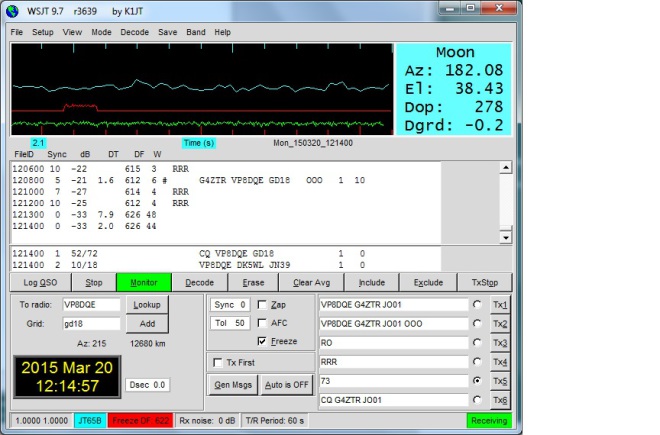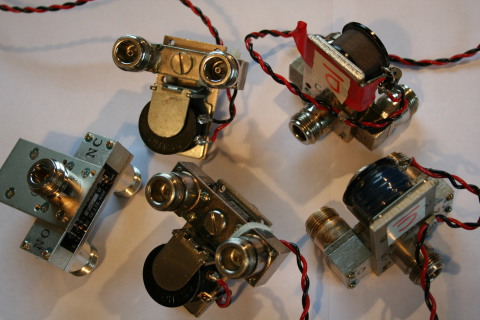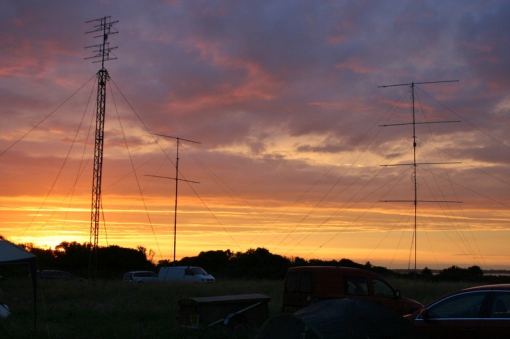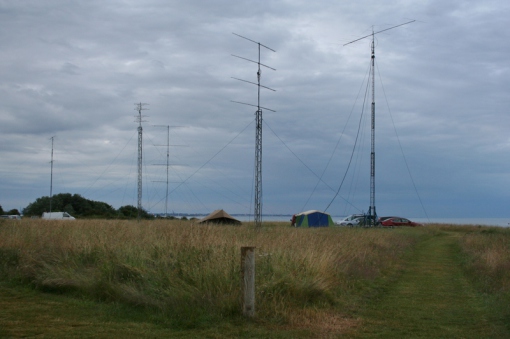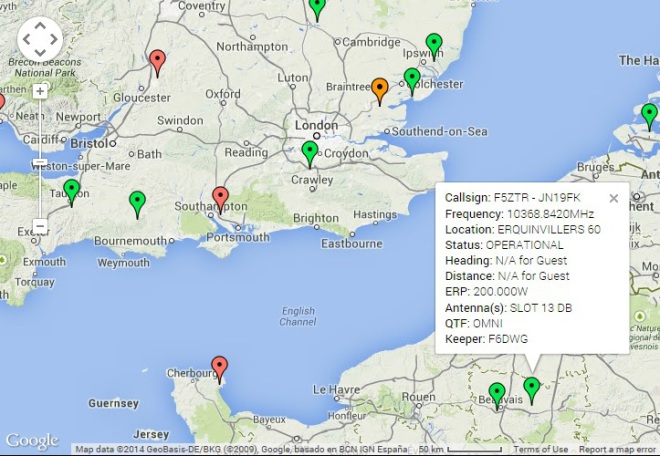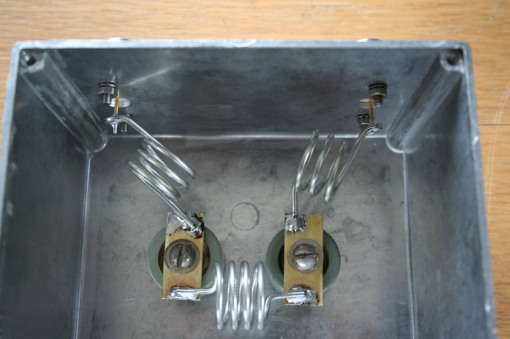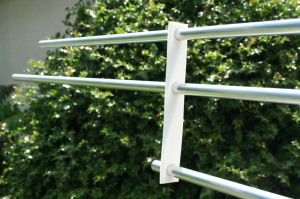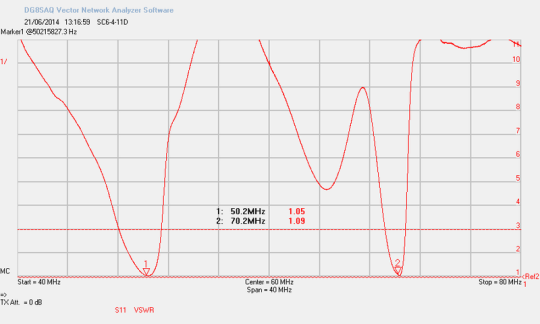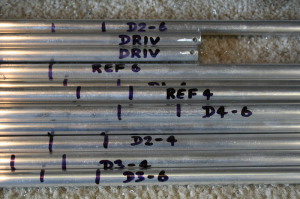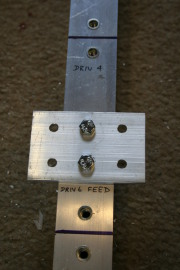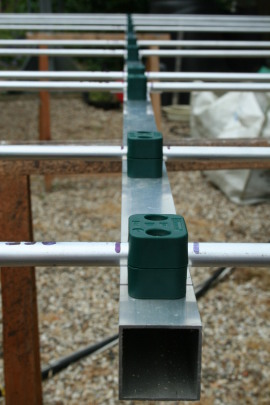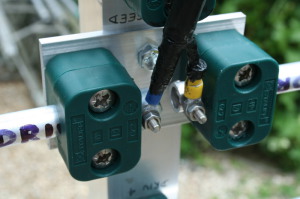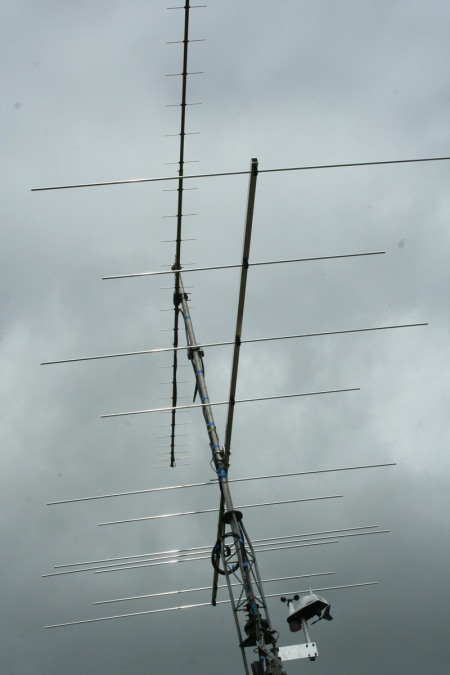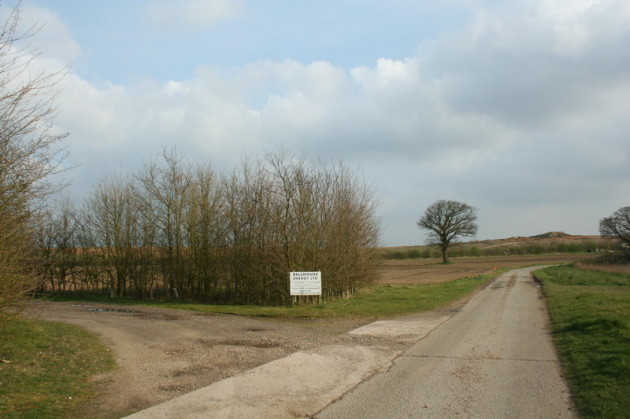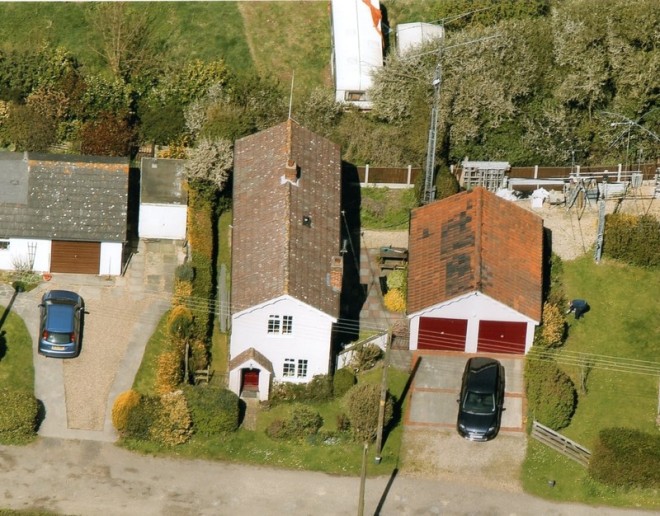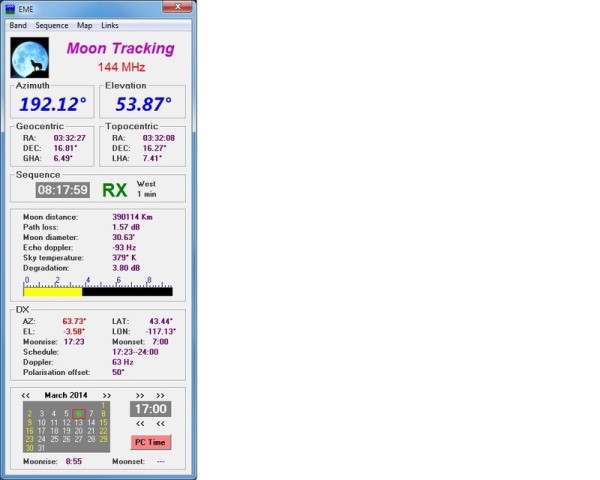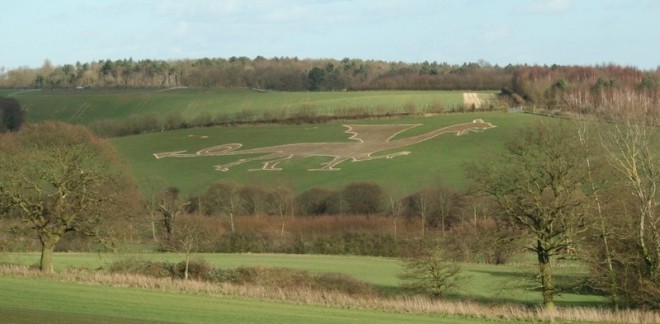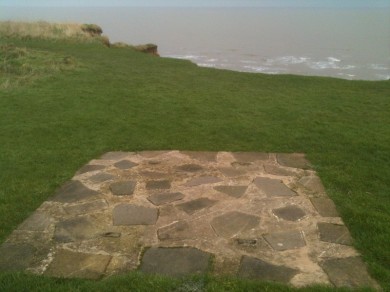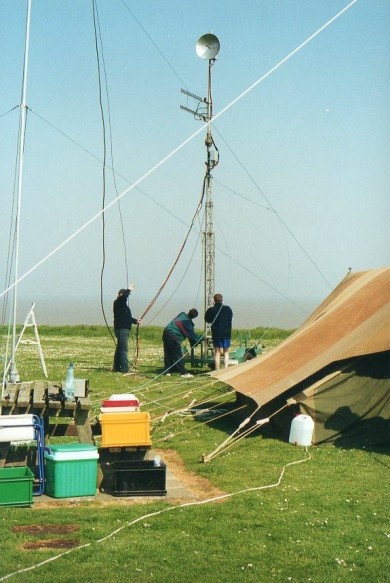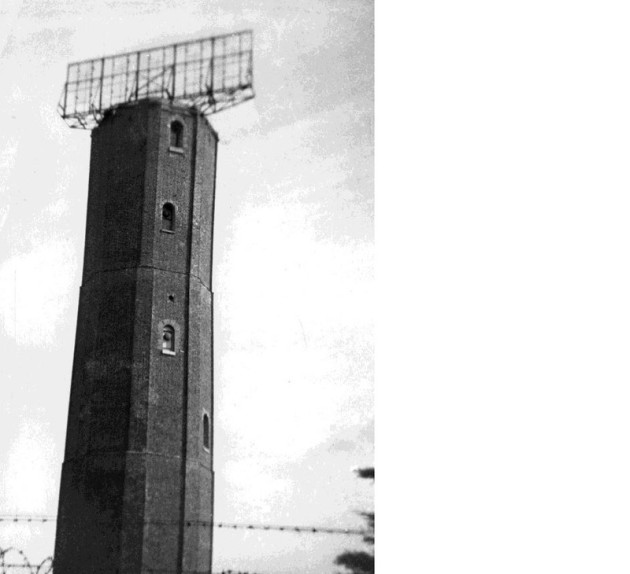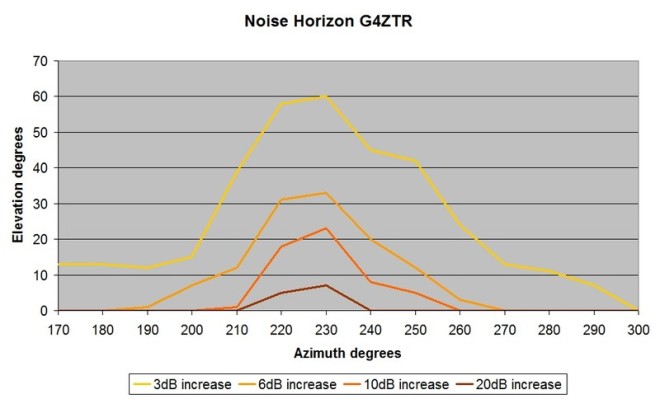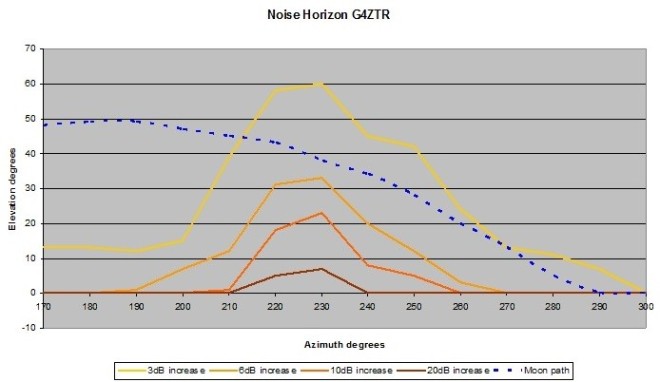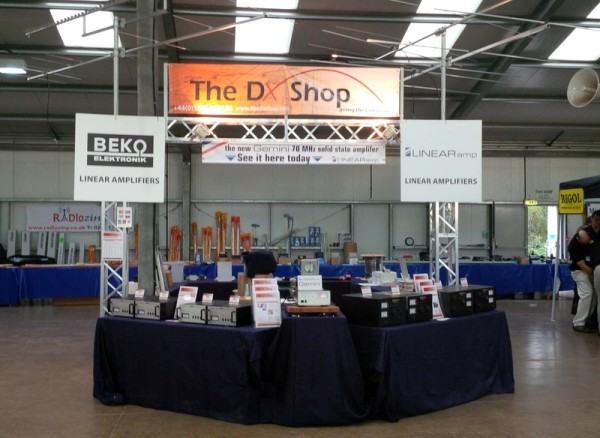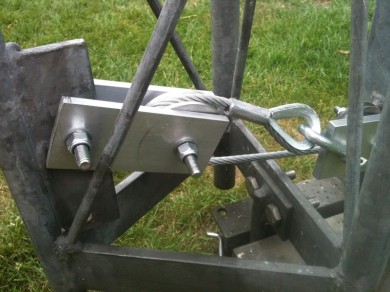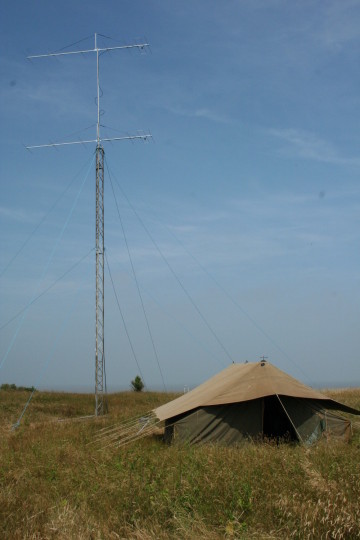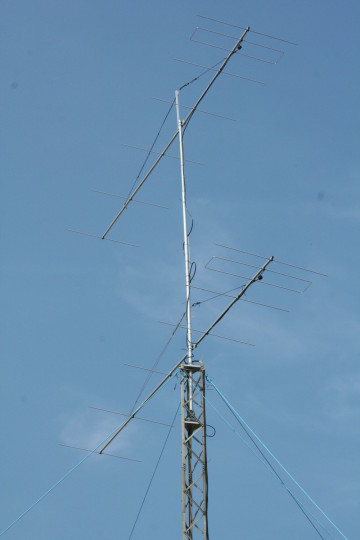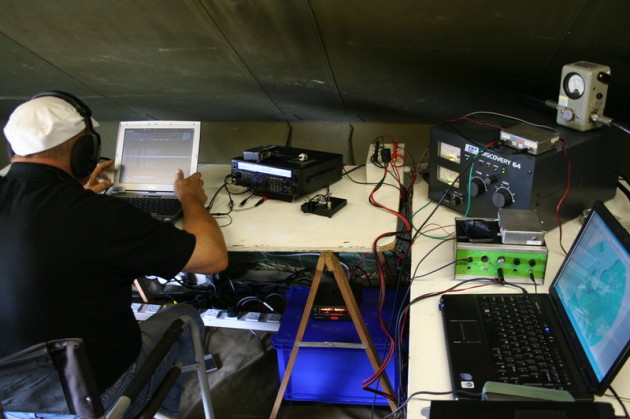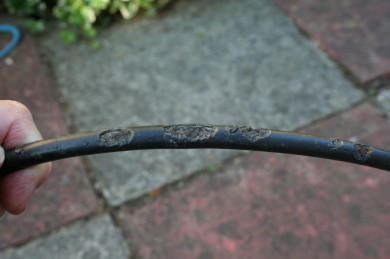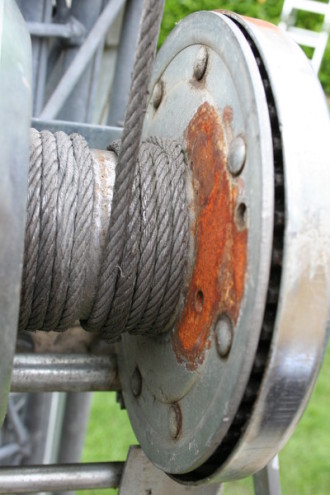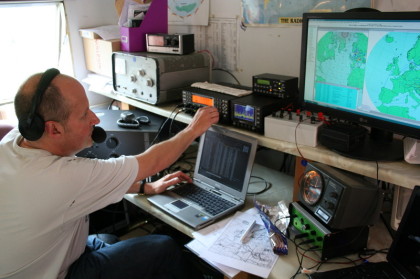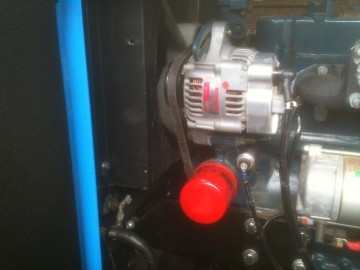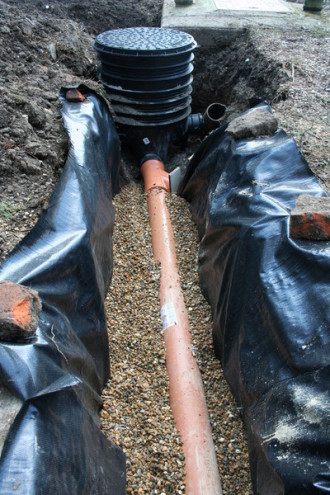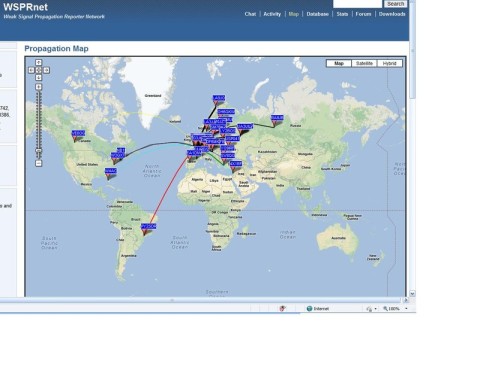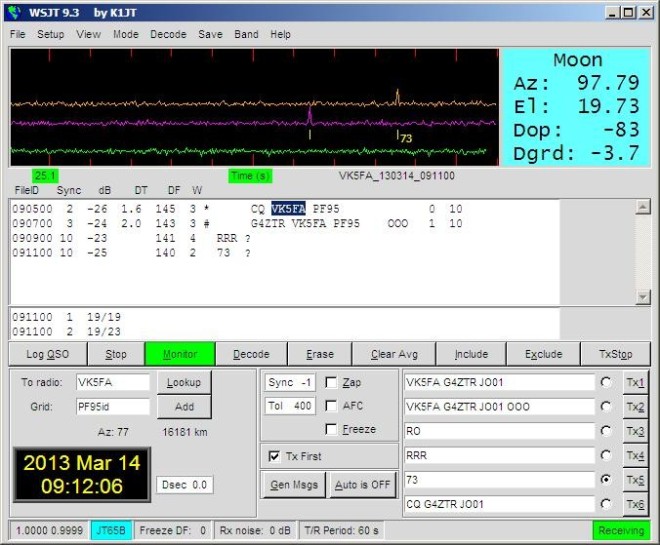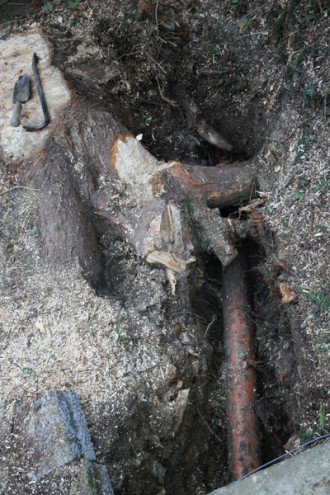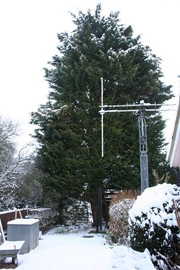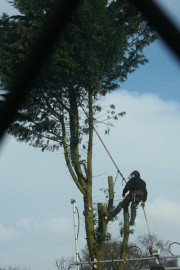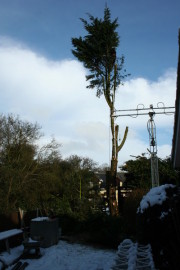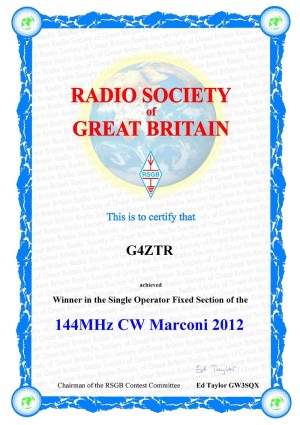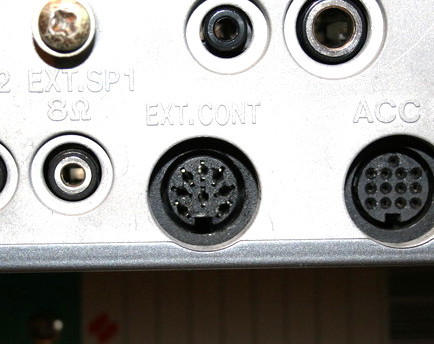
RECENT UPDATES
Weather November 2023
Watts up ? November 2023
Blog 13 June
Contesting 22 May
For Sale 20 May
EME listing 22 March
70cms updated Feb '15
Kits Jan 2015
Yagis and SWR Jan 2015
Blog
From time to time I will post pertinent comments (and occasionally impertinent ones) about my work or hobbies or life in general.
I have been re-organising my blog and moving old posts to more appropriate locations. If you happen to be looking for an old posting you may need to look through the contents list to the left.
13 June 2015
Ferrites and RFI Suppression
About a year ago I purchased a new second-hand computer for use exclusively with my radio activities. That meant it would be dedicated to data modes transmission and reception, logging, DX Cluster and so on. I specifically aimed at a PC with a metal case so that unwanted radiation of digital noises would be, hopefully, under control. I aimed at a second-hand one so that I would have no qualms about delving inside the box if it turned out to be necessary.
To cut a long story short(ish) the Dell which I got was satisfactorily quiet and careful listening on my bands of interest showed that any noise from the computer was below the general rubbish level here in a semi urban location.
But all was not well when I begin connecting peripheral equipment, which included a data modes interface and two rotator interfaces. In simple terms each lead which I added to the back of the computer became an aerial for digital hash. We can’t do much about this if it’s a neighbour (or many neighbours), but putting ones own house into order is a satisfying experience.
There were two paths of attack on the interference. Firstly a variety of different USB leads were tried. There were marked differences between different leads and one particularly bad lead was cut open after the test and it was found that the screen (pretty poor anyway) was not connected to the USB plug. Some of the best cables I came across were those with an opaque outer through which a decent stranded shield could be seen. I initially though these were just a gimmick, but changed my mind after they performed well in my tests.
My second attack on the RFI was to add some ferrite clip-on chokes, with the intention of stopping the USB cable becoming an aerial. After some lacklustre results with unbranded ferrites from eBay, I was advised to get some branded ones from FairRite. Armed with a selection of different sizes – to adapt to different cable diameters – a pleasant and instructive time was had experimenting and observing the interference levels on an Elecraft K3/P3 combo; it helps a lot to be able to quantify the test results.
- Experiments with clip-on chokes are non-invasive – just unclip them if the result isn’t what you want.
- For interference at HF (not LF) and 6, 4 and 2m, Grade 31 ferrite is probably the most useful.
- For each individual cable it will be necessary to experiment with the number of turns through the choke – good starting points would be 2 or 3 turns for VHF and 4 or 5 turns for HF. Because the chokes are clip-on, this experimentation is hardy onerous.
- It is possible to have too many turns – work by K9YC (an excellent resource) gives the following example ……..
|
Turns |
Choking impedance at 100MHz |
|
1 |
80 ohms |
|
2 |
400 ohms |
|
3 |
900 ohms |
|
4 |
600 ohms |
|
5 |
300 ohms |
Note how much more effective two turns are instead of one.
- The choke should be fitted near the USB plug, so that the minimum length of cable is allowed to become an aerial.
- If the choke will not accept as many turns as you would like, use two in series.
- It may well be necessary to choke both ends of the cable.
- To solve problems over a particularly wide frequency range it can be useful to install two chokes with different numbers of turns.
- Finally, to make life a little more difficult, you might observe different levels of interference depending on whether the peripheral equipment is active or not.
Another very useful place for choke is on cables which attach to your transceiver. “RF feedback” can be a horrible accompaniment to your transmission and can often be solved by clipping ferrites onto the microphone cable, data lead etc.
Finally don’t forget other sources of noise that are close to home, such as modems, wall warts and chargers, landline telephones and so on.
Warning ----------- Commercial Break !! -----------------
FairRite ferrites are available from companies such as Mouser and Farnell. I’ve been impressed with the improvements in noise level reduction here and have decided to stock a limited range in my Aerial Parts Shop, ready for immediate UK shipping.
22 March 2015
The Falkland Islands on Moonbounce
I’ve been rather quiet on 2m EME for a few months. News of an expedition to the Falkland Islands this week meant that there was an opportunity not to be missed.
The team of three were on the air a day before advertised but regardless of this I didn’t listen for a couple of days, while all the big guns competed with each other for an early place in the VP8 log. “I know my place” !
On the 19th March I listened on frequency and was a little disappointed that I could not see their trace in WSJT, and there still seemed to be a rather large and enthusiastic pile-up of callers. After a while, their signal appeared and soon it was good enough that I began calling them. But after an hour I realised it was not to be – I was probably one of dozens of signals being received by the expedition and I was not going to be the strongest by a large margin.
The 20th March began in a similar fashion, in that I was unable to see their signal at all. But soon it was out of the noise and at times they were audible on the speaker, with a best signal level of around -18dB. That’s very much in line with my expectations for a group running about 1kW to four 9 element yagis. I called for a solid hour and got no response. The expedition was working other callers, but from the time taken and the number of repeats it was obvious they were not finding it easy. I called for another hour. I tried several slightly different frequencies, in case I was co-channel with a sprog or another caller. I was considering the many other things I could / should be doing and then Bingo ! My call appeared next to theirs on the screen. I was in. Completion of the QSO was rapid and without any cause for doubt.
I have seldom worked so hard for one QSO !
The following day I had contacts with LU7FA, and with K4MSG, who runs 300 watts and a pair of 9 element yagis, which is a good QSO in my books.
3 December 2014
A Testing Time
I'm slowly working to get my new 23cms preamp complete and in a box. Yesterday I got the two relays mounted, with a nice piece of PTFE coax between the NC ports.
It was a big disappointment to put this on the analyser and see nearly 1.5dB loss. This is the "straight through" path.
So I backtracked and started testing relays alone and cable alone. Eventually I tested all the Tohtsu CX520 relays I could find. Only one is unused and none are new, in fact the most recent is dated 1997.
In summary, all the relays came close, or a little better than spec for SWR. All five relays failed to meet the spec for isolation on one or other port and there was a lot of difference between NC and NO paths on the same relay. Three of the five failed to meet the spec on through loss.
One of the relays (visually an older design) had an interesting feature in that loss and SWR could be altered by exerting sideways pressure on one of the connectors. Loss could easily exceed 1dB.
This note is not taking a pop at Tohtsu, it’s more a reminder that sometimes old equipment needs to be checked out before use.
In a little more detail: the VSWR was measured between 1.03 and 1.22 with a decent quality termination on the common port. The specification is 1.17. The through loss was measured between 0.2dB and 0.5dB – the specification is 0.2dB. Not surprisingly, the relays with better VSWR had a correspondingly lower loss.
Lastly, the isolation was measured. This is particularly important to keep the transmit power away from the sensitive active device in the preamp.
There were big variations, from 33dB to 50dB and the specification is 42dB.
Probably, to keep things moving, I'll select the best of a bad bunch, with a view to replacing them later.
It's VHF NFD Weekend ..................
27 June 2014
4m LPF
With VHF NFD just a week away, yesterday I reminded myself of a project for which I sourced the awkward bits ages ago, and then set on one side. In the organised chaos which is my radio room, I managed to find the carefully hidden parts without pulling out too much more of my rapidly diminishing hair. The project is a simple low pass filter for 70MHz.
The design comes from OZ2M and I’ve already seen a good example of the filter locally from G4HSK so this gave me confidence that it would work. All that is required is a length of 2mm (or so) diameter wire, two meaty 56pF capacitors, RF connectors and a box.
It took an hour or so to build and it works as planned without adjustment. The through loss at 70MHz is 0.07dB (undoubtedly beyond the accuracy of my VNWA) and the input SWR is 1.25 to 1. The attenuation at 144MHz is 39dB and at 432MHz is 53dB.
For the benefit of the less technical readers, the purpose of this filter is to allow 70MHz transmissions to pass straight through without loss, and to attenuate any harmonics or spurious signals at higher frequencies. In particular for NFD, we aim to avoid having the 70MHz station causing any interference to other bands such as 144MHz and 432MHz. We will also be using similar filters on the outputs of the stations on 144 and 432MHz. The harmonic relationship between 144, 432 and 1296MHz makes the use of such filters essential.
21 June 2014
Update on the dual band beam (blog 18 June)
Relative positioning of the driven elements for 4 and 6m on the interlaced yagi is critical, and I noticed that from certain angles my elements did not look parallel. I wondered if this could explain why the resonant frequency on 4m was a little high. Only one way to find out – bring it down, check the measurements and apply a fix.
My “fix” was a small piece of PTFE sheet, punched for the ½” elements and fitted near each end of the 4m dipole. It turned out that the punched holes had relaxed a little and were a nice interference fit on the tubes. Job done.
18 June 2014
What, another aerial ?
I’ve had an aerial day today. So far this year I have not had an aerial on my mast for 6 metres – I thought I might not miss being on the band, but I do – especially as propagation on 4m so far has been quite unexciting.
I don’t have the real estate on my mast to have separate 6m, 4m and 70cms beams stacked at ideal separation, so I’ve decided to compromise in a different way, and build a dual band yagi for 6 and 4m. With my FT-847 (which has 6m and 4m on the same connector) and a dual band Discovery amplifier (common connectors and quick switching between the two bands), this is an obvious step to take. The web pages of Justin G0KSC contain construction details of several dual band aerials and I chose one with eleven elements that conveniently fit on a 5m boom (a stock length of material). These dual band aerials have just one feed point on the 6m dipole. The 4m part of the aerial is energised by locating a 4m dipole just a few centimetres away.
Yesterday I cut the materials and today I put the aerial together and put it on the mast. Unlike Justins LFA’s, this aerial has no bent pieces of aluminium so construction is pretty simple requiring just a square section boom (I chose 1-1/2” tube) and lot of ½” diameter tube for the elements. I chose to use rivnuts to hold the element clamps in place. This avoids to need to drill right through the boom and usefully it avoids the need to mess about with (and lose) nuts and washers on the underside.
There are no loops to tune, nothing to adjust – will it work ? I took a first SWR measurement with the mast luffed over and the aerial pointing at the sky with the reflector a few feet off the ground. On 6m the best SWR was 1.0 to 1, but around 49.7MHz. On 4m the SWR was about 1.4 to 1 on 70.2MHz. I figured that when the aerial was raised away from the ground, the resonant frequency would rise, although I couldn’t be sure how much, and that’s how it turned out. The final readings are a best match at 50.2MHz (1.11 to 1) and at 70.3MHz (1.19 to 1). I’m happy with that.
31 March 2014
EME: 400 and counting
Over the recent weekend and today I’ve made a number of EME contacts, and I’m pleased to see my total “initials” has passed 400. I spent some time chasing CX2SC, but eventually concluded that he will have to wait for another day. On Sunday I completed with EA8TJ, after a number of previous attempts which were all characterised by one way propagation. Domingo was about to go QRT and noticed my callsign on his screen at the end of what was to be his very last transmission. Having got the callsign through, the remainder of the exchange was (almost) guaranteed, because the nature of JT65 effectively makes the standard messages of RO and RRR several dB more sensitive.
Two new stations were worked today, and it was a pleasant surprise to have my CQ answered by FM8DY. I guess that working that prefix on pretty much any band is nice ! The QSO was a struggle and on this occasion it was my own reception that was in trouble. I could see a nice trace on the waterfall, but try as I might, it would not decode. It was later suggested to me that there could be some libration distortion causing the signal to spread. Like a number of issues in EME, this feature can be present in one direction only, and that can be so frustrating !
27 March 2014
Watts from Waste
In many parts of Essex there are holes in the ground where sand and gravel has been excavated for the construction industry. There are also areas where chalk can be excavated, thus handily providing the main constituents of concrete. Sometimes the holes are left for nature to reclaim the land, or they are turned into recreation facilities, but many of the pits are filled with our rubbish; “landfill sites”. In time, the land if filled to its original profile, or a little higher, and returned to agriculture.
But that is not the end of the story. The stuff we throw away is seldom inert, and the result of thousands of tons of foodstuffs and garden waste decomposing is the production of some unpleasant gases and liquids. The gases are largely methane and carbon dioxide, in broadly equal quantities. The liquids, known as leachate are poisonous and corrosive and usually need to be piped to a collection point for removal.
It is best practice to collect the landfill gas too, and as a minimum to burn it off in a controlled manner. But this is rather a waste, and there are a number of landfill sites around the county where the gas is “cleaned” and fed to a generator, in a similar way to a diesel generator. Power can then be fed to the national grid.
There are a few difficulties in harnessing landfill gas for power generation however. The main issue is forecasting for how long the gas will continue to be produced in sufficient quantity for power generation to be viable. That is determined not just by the size of the landfill but by the type of material in it, how well compacted it is, and how well sealed the landfill is against the gas escaping to the atmosphere. Temperature and humidity play their part too.
Bellhouse pit near Colchester contains various areas, ranging from those in which gravel is being excavated, those which are being landfilled, and those which have been filled, capped and gas is being extracted. I’m a bit surprised how little information I can find about the power generation, but so far there appear to be two generating sites, one of which is shown below and produces around 3.8MW. This inconspicuous sign along a farm track (and footpath) is the only indication of the facility, and it’s been carefully screened with mounds and tree planting.
Other locations in Essex in which watts are being produced from waste include Ongar, Pitsea and Roxwell.
20 March 2014
Looking down on myself
Door to door salesmen are quite a rarity here, and living in a quiet location I can often spot strangers coming and pretend to be out. Yesterday my cunning plan failed and I opened the door, half expecting a neighbour with mis-delivered mail or something similar. But it was a man wanting to sell me something.
Much worse, he had something I wanted. He showed me an aerial photo of my property and I’m a bit of a sucker for these. The previous one was some ten years ago and so a recent shot was just what I wanted. I did my best not to appear too eager and we settled on a price which seemed reasonable.
Close inspection, and digging in to my memory bank, indicates that the photo was taken almost exactly a year ago. The best dating evidence was that I had recently completed restoration work after excavating a new drain field for my septic tank, and had a pile of scaffolding in the garden ready for later exterior decorating.
What does strike me is how inconspicuous my aerials become when seen from above. We normally see them silhouetted against the sky and they can seem like an eyesore (but not to the owner of course). Whereas from above, the two Versatowers are quite hard to pick out, and the aerials are difficult to see at all. I wonder if that’s a line that could be used with the planning authority ? Probably not !
Further close inspection of the photo shows me doing some gardening. They must have waited ages for that.
6 March 2014
PST Rotator Software
I wrote some notes about a year ago, saying how pleased I was with the PST Rotator software by YO3DMU. It controls my two rotators for EME (a Yaesu and a Spid) and that means there is one less thing to remember during a moon pass. Codrut continues to regularly update and add features to his program and is also very responsive to help requests. For example a recent addition is the option to open an internet link to a local weather station and use the wind speed information to park the aerials into the prevailing wind, with or without an alarm.
An option which passed me by earlier is a separate window dedicated to EME information. I really should have noticed – it’s called “EME” on the top menu and the new window which it opens provides data about the current moon position, degradation, moonrise and so on. It provides moonrise and moonset, not only for the home station but also for the DX station if one is selected on the main window. From the EME window, one can select an optional map, which shows in real time the moon view of the earth (see below). On the map, the red dot is the home station, the green dot is the DX station and the larger yellow dot is the moon. At the bottom of the EME window is the facility to use PC time, or to advance the clock. On this example I advanced the clock to 17.00 hours, and observed that shortly after 17.00 the DX station will have moonrise. The exact time is confirmed as 17.23 in the EME window but the map is often easier to look at.
I like it !
21 February 2014
The Suffolk Dragon
Yesterday I took a long but not too interesting walk in Thetford Forest. I was keen to get some exercise, and not keen to get muddy, so the forestry tracks were ideal. I remembered to take my camera too, but there was little of note and one tree there looks much like another. Some workers cottages, deep in the forest would have been worth a picture but the light was entirely wrong.
Today’s walk was much shorter, just a couple of miles around the village of Bures on the Essex/Suffolk border. It’s a walk I’ve done a few times although not recently and I couldn’t bring to mind much of photographic interest that I’d not snapped before. It’s great to be proved wrong sometimes, and I did a double-take as I spotted a dragon on a nearby hillside. A bit of background reading when I returned home tells me that the dragon was created quite recently to celebrate, if that’s the right word, a real dragon which appeared in 1405 and slaughtered an entire flock of sheep before descending from the hillside into the misty marshes below, never to be seen again.
There are no sheep on the hill in my photo today. Is that a coincidence ?
31 January 2014
Going, going, almost gone …………
During the week I took a brisk walk along the cliff-top at Walton on the Naze. It’s the area we visit regularly as a group for VHF contests. The cliff edge frequently has falls and the stormy weather of the past few months has caused an acceleration of the erosion. I took a rather uninspiring snap on my camera phone, showing a stone slab where there was once a picnic bench. The rotten timber stumps can still be seen, and the view is seawards with the cliff edge a few yards away.
Today I dug out an old contest photo, undated but believed to be from around 1996. The only clue to the date of this set of photos is my L registration Mondeo, and I tend to own cars which are 3 to 4 years old.
In the photo is the same picnic bench, being well used, and beyond it, looking towards the sea is a large grass area on which we have planted a small trailer mounted tower. There was plenty of room beyond that mast for the public to walk and enjoy the views nearer the cliff.
Talking about Walton reminds me of another photo I came across recently; it shows the Naze Tower in 1942 with a Chain Home Low Radar Dish on top. The “battlements” of the tower were removed to accommodate it. Next to the tower, a small brick built building with a concrete roof housed the necessary generator. It seems to me that the nearby public toilets were modelled on the generator shed – I hope the architect wasn’t paid much !
25 November 2013
QRM on the EME aerials
Most of us who play moonbounce suffer from
QRM of one sort or another and I’m no exception. Yesterday I took some time out
to quantify a typical days noise, by plotting the azimuth, elevation and noise
level in Excel and displaying the results using the Chart Wizard. I hope the
display makes sense !
First task was to calibrate my FT-847
S-meter using a signal generator. It’s a pretty generous meter with only 2dB
between S1 and S2, and between S2 and S3. S7 is only 20dB above no indication.
It was also interesting to see that the internal pre-amp was about 16dB, but
the attenuator was just 5dB.
With calibration complete, I spent a while
observing the noise levels, turning the array by PST Rotator and putting the
results into Excel. There was a bit of a learning curve for me with the Chart
Wizard but it seems to have come together now. The plot below displays azimuth
and elevation in degrees, and has four levels of noise indicated by the
coloured lines. To help interpret the graph, here’s a couple of clues:-
Between 210 and 240 degrees azimuth and at
zero degrees elevation, my noise level increases by 20dB or more compared to a
“quiet sky”. That’s really bad news for hearing weak EME signals. Another
example, at an azimuth of 200 degrees, I will need elevation of more than 15
degrees or so to keep the noise increase to below 3dB.
I live on the north-east corner of the
village, and so it’s no surprise that most of my noise comes from the
south-west. Thankfully, there are some very good directions too.
Lastly, the second graph has yesterdays
moon path plotted on it in blue. As if I didn’t know it already, contacts
attempted between 210 and 260 degrees were going to be a challenge.
18 November 2013
ARRL EME Contest
This weekend was the second leg of the
contest (my earlier blog of 27 October covered the first leg).
This second leg is a continuation of the
first part of the contest (I know it may sound obvious) so all contacts have to
be with new stations and it looked likely that I would make less QSO’s in this
second weekend, and that’s how it turned out. Not that it was either slow or
boring, far from it.
For this second weekend, the moon in Europe was available from late afternoon onwards (in the
first leg it was in the morning), which seems to give all EME’rs around the
world a fair crack at it. However, for my sociable hours of operating, it
pretty much ruled out any further USA contacts. Instead, the moon
gave a “footprint” right across Asia and down to Australia.
On Saturday I started off well, with the
first QSO being 7K3LGC. Another new DXCC I thought, but a quick check showed it
was “only” Japan.
A further 7 QSO’s followed, with another Japanese station, two Russians, GM6VXB
and more Europeans. The signal from DK5LA was -9dB on the JT65 scale, which is
the loudest signal I’ve come across for a long while.
On Sunday I had a further 6 QSO’s during
the afternoon, including M0BKL. Working G stations on EME is quite a rarity, because
it can often be difficult to sort out the tropo from the EME signal. IO80 is
just far enough away to make this feasible, and the tropo and EME signals were
of around the same signal level, but separated by some 200Hz Doppler shift.
Contest scoring involves multipliers of US
States and DXCC’s. Even after two weekends, got-aways (seen but not worked)
included F, EA, OH, GW, EI, and VK.
From this second weekend, six of the
contacts were “initials”: all time new ones. It means that my initials list is
slowly but surely approaching 400.
11 November 2013
A bit of a blow – the sequel
I blogged on 31 October about the recent
storm, and being without power for more than 3 days.
The following Tuesday I received a claim
form from UKPN. It was quickly completed and posted back the same day. On
Friday of the same week the compensation cheque was in my grubby little
mitts. They certainly didn’t hang about
– well done !
27 October 2013
ARRL EME Contest
This weekend was one stage of the ARRL’s
EME contest, which is open to all modes of EME communication, including
digital. So, just during my daylight hours and when the moon was visible, I had
a go to see what could be worked on 2m JT65. I was QRV for about 2 hours on
Saturday morning and 5 hours on Sunday morning.
I started by working the biggest signal I
could find - KB8RQ. His signal was quite audible, and -12 on the WSJT scale.
Other big signals were 3Z4EME and RU1AA (both worked) and HB9Q (not worked
until Sunday).
I spent some time looking for the
expedition to Crete, SV9ANJ, but I could see
lots of callers with no trace of the SV9 signal. The rest of the time was spent
working those who could hear me, with the emphasis on contacting USA stations
because the US State is a contest multiplier. At the end of Day 1 I had just 12
QSO’s complete, of which two were all time new ones.
On Sunday I had more time available and
followed the same strategy as the previous day. The end result for Day 2 was a
further 14 QSO’s with an additional 3 all time new stations. Over the two days,
10 different States were worked. SV9ANJ still evaded me, being -27dB at best.
The band was pretty busy, from around
144.100 up to 144.155, often with a QSO every kHz. The result of this can be
seen on the screen-shot below, where I am receiving a RRR report from my QSO
partner NT0V at DF of 150Hz and a QSO at DF 960Hz (nominally 1kHz HF) has
reached a similar stage.
Equipment summary; FT-847, Linear Amp
Discovery, SSB SP-2000, G3LIV interface, WSJT 9.5, 4 x 8 ele JXX yagis.
11 October 2013
Alimast – a novel use
My business, Aerial-Parts, engineers a
sectional aluminium lattice mast, called Alimast. There’s lots of detail of
this mast on my business web pages at www.aerial-parts.co.uk.
I was approached by Roger Banks, the
director of the DX Shop, www.thedxshop.com,
who asked if I could supply four custom tailored sections to be used as an eye
catching stand at the 2013 RSGB National Hamfest. We worked together with
emails and sketches and came up with a “gantry” which would span his exhibition
tables, and had bespoke free standing bases. Inserts were included to allow for
poles to be placed in each vertical section, with a range of Powabeam aerials
displayed on top. Perhaps the toughest part of the brief to fill was the
requirement for the gantry sections to be “quick-fit” so that it can be
deployed speedily on site. This was achieved with the extensive use of
rivet-nuts.
I'm sure you'll agree that it looks good and provides Roger with a copious display area over and above the tables (pun intended, think about it )
28 July 2013
Altron mast refurbishment part 2
In my blog of 27th June, I
explained that replacing the luffing winch had been successful, but it was
still requiring lots of effort on the crank. Unfortunately I’d been unable to
find enough information on-line to compare the old and new winches (gear
ratios, drum sizes and so on), so it was not certain that an improvement would
be made.
Yesterday, Plan B was brought into
operation. I had turned up an aluminium pulley and cut some short flat lengths
of aluminium bar, with which to introduce a 2:1 mechanical advantage to the
system. Of course, it needed a longer wire rope too.
Installation went almost according to the
plan, although the first hole I drilled to mount the new pulley turned out to
be fouled by a bracing strut. I’ll be suggesting to Bill that he replaces this
hole in due course with swarf from the second hole I drilled.
There’s just nice room within the tower for
the new pulley and a D shackle to anchor the rope back to the tower ground
post. The result is that even a wimp like me can now luff the mast with just
one hand on the winch instead of two.
22 July 2013
4m Trophy Contest, G0VHF/P, 21 July
18 July 2013
RG-213 – Yummie !
A couple of evenings ago I decided to check
out the HF bands, as VHF at the time was pretty quiet. I also had it in mind to
download the latest version of WSJT-X and try it out.
The bands seemed quiet, not only a lack of
signals, but a worrying lack of noise too. A brief look at the SWR confirmed that I had a
problem. Had my CobWebb got water in the balun box again ? It seemed unlikely
in the current weather and a quick check showed that all was well there.
Another quick check with a dummy load at the end of my coax instead of the
aerial showed a high SWR. So, somewhere along the feeder was a problem.
Then I remembered I’d been gardening with
the strimmer. But a visit to those parts of the cable where I’d been strimming
showed that all looked well. I resumed fault finding today and pulled the
feeder away from its location at the foot of my boundary fence. It’s been
hidden there for years.
Two problems came to light. Firstly, a join
in the cable part way along had been made with two PL-259 connectors and a
“barrel” joiner. My weatherproofing had been good, but I found that the braid
of the coax was no longer in contact with the outer part of the connector.
There must have been some stretch, and it’s not the first time I’ve come across
this irritating problem. I thought I’d cracked it, and then happened to notice
some areas of damage to the outer PVC sleeve of the cable, exposing the braid.
This was evident in several places and I have to assume that mice, rats or
rabbits have been enjoying them-selves at my expense.
The cable has now been replaced, and
signals on the higher HF bands are back to their expected levels. I’ll have to
devise a cunning plan to get my feeders off the ground and a little less
accessible to livestock !
27 June 2013
Altron mast refurbishment
Recently I agreed to help a friend with the
refurbishment of his Altron telescopic mast. He purchased it a few years ago,
second-hand, and the winches and cables have seen plenty of action. It wouldn’t
be fair to name my friend, so let’s just call him “Bill”.
I don’t claim to be a mast expert, but when
I looked over his mast a little while ago it was clear that the wire ropes for
luffing and raising the mast were soon due for replacement: There is very
little rust, but on the winch drum the wires have been crushed from round to
oval, and a strand or two has broken in a couple of places. This is shown in
the photos, but as is often the case it’s difficult to see in the picture. I’ve
no way of knowing how much the previous owner may have abused the mast. “Bill”
had also mentioned that the winch operation was very hard work, almost needing
two arms on the handle. In addition, the existing Fulton winches have a very positive spring
loaded ratchet, which makes a lot of noise in the domestic environment.
Attaching the winch to a 40ft mast amplifies the noise nicely.
Taking all this into account, we decided to
replace all the wire ropes because they were becoming unsafe. We also decided
to treat them with wire rope lubricant. I appreciate that there are arguments
for and against, and decided “for”. The argument against is that the wrong
lubricant will attract dirt and dust which could accelerate wear in the rope.
The argument for is that the lubricant helps the rope slide over the pulleys
and other layers of rope. A good lubricant will seep into the rope and help the
strands slide over one another as the rope flexes.
We also decided to replace the two winches
with models from the Pfaff Silberblau range, which I have used for many years
on my Versatower. They are auto-braked for safety and include a ratchet that
works by a gravity pawl instead of a
spring. They are much quieter (but not silent), and without a spring there’s
one less thing to go wrong.
We agreed to split the work into several
short stages and the first day saw us replacing the luffing winch and luffing
rope. It was all sorted in 45mins or so and would have been quicker if I’d paid
more attention to the direction of the rope on the winch drum. I got it right
second time – how many choices are there ? It is certainly quieter, and it’s
reassuring to have a new rope in use. But, it’s still needing lots of effort on
the crank. So Plan B will be brought into operation shortly. This will involve
a longer rope and an additional pulley at the foot of the mast, to double the
mechanical advantage. As Bill said, he won’t be getting any stronger as the
years go on. I know how he feels.
The wire ropes and winches were obtained
from Dale Lifting and Handling: http://www.dlhonline.co.uk/index.asp
21 June 2013
50MHz Trophy Contest 2013
This was the worst 6m Trophy contest for us
for many years, for a variety of reasons. With just over 100 contacts in a 24
hour event the rate was more akin to 70cms, or even 23cms a few years ago.
Down on manpower, Colchester Contest Group
asked the Ipswich Radio Club if we could use their facilities, and we’re very
grateful for the opportunity, without which we probably would not have been on
the air at all. Their station has a 3 ele SteppIR, which includes the 6m
option, at around 60ft. Their station is regularly used on HF, but the 6m
option had not been used in anger. I brought along my K3 and Acom amplifier.
At the beginning of the contest, we had
some audio problems and the signal quality was poor but readable. This was soon
resolved with a re-routing of cables from the logging laptop but it was an
unfortunate time to be problem solving.
Once we got in our stride, a thunderstorm
came along. Noise levels rose from static rain, and as the centre of the storm
came overhead we decided that sitting next to a 60ft mast wearing headphones
was not a bright idea. In any case, the rain hammering down on the caravan roof
made any sort of listening almost impossible.
It took a while after the storm passed
before the noise died away – we lost a couple of hours operating. As the
afternoon ran into evening, we concluded that all was not well with the aerial.
It should have had a modest gain of around 10dBi and a front to back of 20dB,
but its front to back was seen to be around 3dB – the P3 makes observations
like this easy and reliable, unlike an S meter. The SWR was good, but so is a
dummy load.
There was almost no Sporadic E on Saturday.
This meant that we wee effectively restricted to tropo contacts and these were
hard to come by.
On Sunday, some research on the web
indicated that other users had found some shortcomings with the SteppIR on 6m,
and there were some suggested changes to element lengths to improve this. Once
the aerial owner was back on site these changes were made at the press of a
button or two and suddenly we had an aerial that behaved quite differently. It
had a front to back ratio that could be seen and heard (useful to get rid of
some qrm). It may have had more gain too, but that’s difficult to tell.
To increase our morale further, there were
some short lived Es openings, although they were very selective and had often
disappeared by the time something appeared on the cluster. Lots of meteor pings
were noted too.
So, our final score will not cause
palpitations among the leading groups in this contest. But at least we got on
the air, took part, and enjoyed our weekend.
12 June 2013
CQ Sporadic
Today was pretty busy on the radio, with
some excellent Sporadic E on 6 and 4m. I understand it also reached 2m, but I happened to be away at the time - ooops !
Firstly, I had an Aerial-Parts job to
complete. I started early in the workshop and I was pleased that by 9am the work
was complete, packed, and the courier was arranged for collection later in the
day.
I began by making a few QSO’s on 6m CW. The
distances were good, mainly to the East, but no new squares were heard or
worked. Around midday conditions improved and 4m opened up. Again, contacts
were to the east to start, beginning with QSO’s into OK, YO and HA. This
included a brief chat with Joe, HA5CW, who has been working at InnovAntennas
with Justin. In the early afternoon came my best DX, an SSB QSO with SV5BYR in
KM46 (approx 2800km). I didn’t realise until later that SV5 is a separate DXCC
(Dodecanese). QSO’s into OZ, SP and CT
followed. The most notable aspect of this opening was that paths were open in
several directions from JO01 at the same time.
I soon spotted contacts between SV5 and GM,
which puts my DX into perspective !
In the early evening I made a number of
contacts into OH and SP, whilst also hearing EA and CT off the back of the
beam. I was pleased to work OH2MA in KP31 for a new square; I had to join a
pile-up for a few minutes to get through. OH2MA was coping extremely well with
this. Best OH DX was OH5LID in KP41. Janne is an almost regular QSO partner, as
I try to work him on his frequent ms expeditions.
So, it was a very good day on 4m for me. Even
so, I had to “leave some for next time”; CT3HF in IM12 was heard for a while
but I didn’t have sufficiently good propagation, and EA8ACW/P was also heard
but not worked.
The Live MUF map shows what was happening,
mid evening on 12 June 2013.
10 May 2013
Quiet ? No, not at all !
My blog has been quiet recently, but that
doesn’t mean nothing has been happening. Quite the opposite.
A nice new computer arrived recently, from
Nexus Technology, who are just “down the road”. It’s a mid performance desk-top
PC, and is admirably RF quiet. It was bundled with a budget AOC monitor which I
very quickly grew to dislike. It’s rapidly been replaced with a widescreen HD
monitor from Asus. This provides the useful capability of viewing windows of
WSJT, waterfall, Cluster etc at once without overlaps and it’s clearly an
operating benefit.
Transferring information from my old Dell
was a necessary evil I was not looking forward to. At least there seemed to be
some useful Windows software called Transfer my PC, and it did just what it
said on the tin. Fortunately I didn’t rush out and buy a special USB lead for
the transfer, because I found that for 20% of that cost I could do the same job
with an Ethernet transfer (crossed) cable.
My toughest job of the week was servicing
the contest generator. This is a 10kVA diesel, water cooled. I recently found
some service information on the Kubota engine that it uses, and noted the
recommendation to replace the fan belt every 500 hours. I’d noticed the belt
was a bit slack and reaching the limit of its adjustment, and with 1300 hours
on the clock I decided this job could not be put off any longer. The old belt,
being worn, flexible and stretched, came off quite easily, but getting the new
belt installed was not the reverse process. Try as I might, there wasn’t enough
freedom available to get the new belt over the third pulley wheel. It became
evident that I’d need to remove the alternator in order to hook the wheel under
the belt. And to do that I would need to remove the lifting eye, the top cover,
the fan guard and loosen the fan shroud.
In all, changing the belt took about 4
hours. It amuses me to think that we carried the spare belt with us on every
contest in case of a failure in the field. That really would have been fun,
probably at night, in the rain, and with parts of the generator still very hot.
My rather poor mobile phone picture shows the fan belt near the red oil filter
casing. Of course, it’s the bit that can’t be seen that causes the
difficulties.
19 April 2013
OH5LID
Today, Janne OH5LID is on an expedition with 4m to KP30. It’s very pleasing to report my successful QSO a little earlier today, giving me a new square on the band. Meteor bursts were long and loud.
I think Janne has given me more new OH squares on 4m than anyone else, and there is the possibility of more later in the year. However, as I fill in the gaps within the 2000km “contour”, new ones are going to become much more difficult. Maybe it’s time I got some additional metalwork in the sky !
..........An hour later, and another new one in the log, thanks to IW4ARD in JN64.
31 March 2013
More pipe dreams
It’s hard to believe that it is almost a month since I uncovered the outlet pipe of my septic tank (blog 3 March).
My options for replacing the old rubble soakaway included digging out the old rubble and silt and replacing it with clean material. I discarded this option quickly due to its location on (and perhaps beyond) the boundary of the property, unknown size, and proximity to tree roots. I also concluded that digging a similar pit for rubble elsewhere was not a good idea because it seems that much of it will be below the water table for part of the time.
So my new septic tank outfall will be a “drainage field” of horizontal pipes laid 600 to 750mm below the surface. The pipes are perforated to let water out and will be surrounded by pea shingle and a geotextile wrap to keep the filter material clean. I probably can’t achieve the extent of pipe which would be suitable for a house of this size but I will do the best I can in the space available.
A minor milestone was achieved today with the completion of the first length of outfall pipe. This is shown in the picture together with a new plastic inspection chamber. With some much appreciated help today, the second trench is well under way.
20 March 2013
WSPR
Yesterday, I spent some time WSPR-ing. Nothing to do with a throat infection – just one of the many amateur radio digital modes of communication. Using my part complete CobWebb and 5w from an FT-847 on 20m, my signal was soon heard at good distances and it’s a useful guide to propagation without actually needing to spend more than a minute or two at the radio.
13 March 2013
432MHz UKAC
Yesterday evening was a difficult contest. Not only were conditions poor, but I found a new source of QRM to the north-west. It sounded like ignition pulses but the noise blanker had no useful effect at all. It is, of course, gone this morning.
It seems to be a struggle to be heard with 100w and a single beam and I often felt that I was hearing much better than others were hearing me, despite my QRM. My score was down on last month but I can see many others in the same boat, and some of my better DX contacts may turn out to be busted because I’m not entirely sure that the other party copied everything OK.
I struggled and eventually failed with GI4SNA. A little later he was S7 while chatting with a local but there was no chance to break in. The message here is to keep contesting and chat later. GM4JTJ was also heard, but I didn’t come across him calling CQ, so there was no QSO.
It was very depressing to hear a station in IO92 giving a QSO number just over 100 when I was on 30. I’m no slouch when it comes to contesting but it’s tough from this far south-east, with only a handful of stations south and east of me who can be worked during poor conditions.
3 March 2013
Pipe Dreams
In my blog on 22nd January I wrote about the removal of a large conifer in my garden. The reason for removing this tree was to enable me to dig around the roots and find out why the outlet from my septic tank is not working properly. Progress has been slow, firstly because of snow, then because of rain – which raised the water table above the level to which I needed to dig.
Progress has also been slow because exposing the outlet pipe has been hard work, digging in sticky clay, mixed with large flints and lots of tree roots. Nevertheless, yesterday I found out what has been happening, and it was not the answer I had expected to find. There are just a few feet of pipe running slightly downhill from my tank, ending in a rubble soakaway. What I thought was an obstruction in the pipe, turned out to be the bricks and blocks of the soakaway. There was no damage to the pipe, no pipe filled with tree roots either.
A quick test with a bucket of water this morning proved that the soakaway doesn’t. I guess it’s just silted up over the years. So the next job is to dig some small trial holes and decide where best to locate a replacement outlet and soakaway.
It’s not easy taking pictures of drains in the ground, but I had a go anyway. For scale purposes, that’s an 18 inch wrecking bar lying on the tree stump.
22 February 2013
Yesterday I felt in need of some gentle exercise, and went for a walk of around 6 miles in Thetford Forest. It was a cold dull grey day and thankfully the forest tracks were reasonably dry – even the path close to the ominously named Reed Fen was passable. My route took me to both sides of the Little Ouse River and was for the most part quite unremarkable.
However the views at the beginning and end of the walk were dominated by the tall chimney of an industrial complex simply marked on the map as “works”. Although my return route ran alongside the “works”, there was no indication of what might be working.
I was intrigued (avoiding the word “curious”, which is open to misinterpretation) and did a spot of research. It turns out that this complex is Thetford Power Station, and I certainly didn’t know they had one. It runs on, wait for it, chicken poo and it’s the largest of its kind in Europe. The output is up to 38.5MW – hardly chicken feed.
20 February 2013
What’s in a name ?
Shortly after I began my aerial business, I contacted my former line manager in the engineering consultancy where I used to work. I was interested to see who was still employed and what their prospects were and trying to gauge whether I’d made a wise move.
At the same time I let her know about my business plans, and how I had prepared to work part-time on my own. I mentioned that I’d considered calling my business Colchester Radio Aerial Parts – but not for long. She told me that before coming to the Chelmsford Office she had been looking after the Strategic Highway and Infrastructure Team. Perhaps not the best posting – after all, being head of SHIT doesn’t look good on ones cv.
5 February 2013
3 February 2013
432MHz AFS Contest
The weather on the eve of the 432MHz AFS contest was not good for aerial work – it was 2 degrees centigrade with a brisk northerly wind and occasional snow flurries. I had nothing on the mast for 70cms. So I decided that just a single 21 ele Tonna would be installed. Records show that last year I put up a pair.
The overlap in timing with the French contest didn’t work well. I heard several French stations before the start of our contest, but during the overlapping time I only heard and worked one. Did they know we were QRV ?
Conditions seemed variable, and my QSO’s with GJ and IO84 square were particularly difficult. Best DX into Germany was achieved on CW and that QSO would probably not have been possible on SSB.
I’m impressed with the number of G stations who were out portable, it can’t have been pleasant, and overall I thought activity levels were good. There was enough activity to keep my interest going for the full 3 hours. I can also see from the claimed scores page that there were several relatively local stations who I somehow missed. There’s not a lot of activity in East Anglia and I get the impression that some operators seldom beam this way. There were very few stations worked in the London area.
Rig was an FT-847, Mirage 100w amplifier (borrowed) and a 21 ele Tonna at about 45ft with SSB Electronics preamp. Logging (and CQ caller) was using Tucnak.
With one less aerial than last year, my score was higher and the number of QSO’s was greater. The logical conclusion from that is that next year I will not install any 70cms antennas, and will do really well !
26 January 2013
Twisting things around
My Aerial Parts business regularly sells pipe clamps to mount round elements on square booms, and they're ideal for this. Today I received an enquiry about mounting elements onto a 2" diameter round boom. By taking a large pipe clamp and fitting this around the boom instead of the element - job done !
The advantages over conventional bolting through the boom solutions include:-
- No holes in the boom to weaken it
- No alignment difficulties when trying to line up a sequence of holes in round material
- If you want to experiment with element positions - just go ahead, loosen the clamp and slide to a new position !
22 January 2013
Timber !
In the corner of my garden is (was) a very large conifer. It was almost as tall as the garden is long, so it was rather overpowering. However, it was not the tree that was causing me concern; it was the roots. It is close to my septic tank, and I've reasonable evidence that the outlet pipe from my tank has been affected by the roots. The pipe is either broken, crushed, or filled with roots. So the tree had to go.
I needed to use a wide angle lens for this shot to get all the tree in the picture - my mast is upright - honest !
The tree surgeons arrived at the appointed time, and by mid-morning the tree had been much reduced in splendor, but not in height. Branches were removed from the bottom of the tree working upwards, and later the trunks were removed from the top down.
The H frame for my EME aerials is in the picture - I removed the aerials just in case, yesterday.
Shortly before lunchtime there was not a lot left apart from the trunk. This called for a change to a larger (and noisier) chainsaw. In the afternoon the trunk was section felled quite speedily and attention turned to clearing up, shredding branches, and exposing some roots to be removed. Everything was shipshape by 3.30pm when the workers cleared off. I'm left with a very large pile of logs and a fair amount of sawdust.
The work was carried out by a very local company, Oak View Landscapes, who have been professional and pleasant to deal with.
The tree is now just 6" tall !
At my leisure, and hopefully in slightly warmer weather, I'll be able to expose more of the pipe and find the problem with the drain.
11 January 2013
3 January 2013
The Quadrantids meteor shower
I must say that I'm a little bit underwhelmed with this years shower, although to be fair I was not able to spend quite as much time as I had hoped. Still, having been on 2m for many years, it was nice and unusual to find three new squares in one day; SM3PXO in JP73 and LY2BUU in KO15 were both quick and easy contacts. UT2UB in KO40 took a bit longer to complete, but it was just over 2000km, so that is to be expected. Attempts with UR5NOY in KN48 and RA1WZ in KO47 were not complete, although the distances were similar.
So, my last qso of 2012 was meteor scatter, and my first qso's of 2013 were meteor scatter. There is almost always something to work on VHF DX.
Please share your comments in the guestbook.
